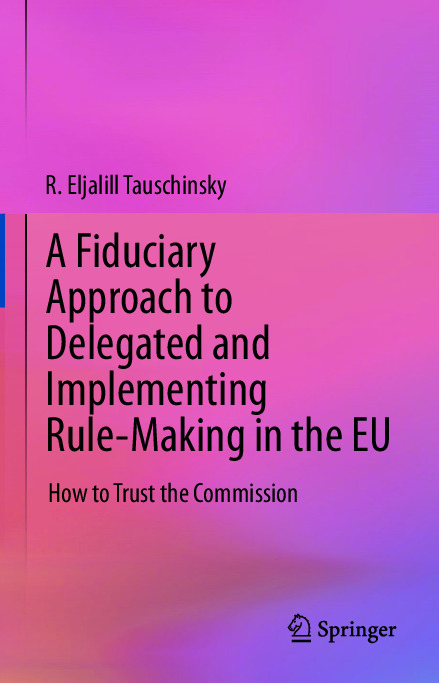File #2858: "2020_Book_AFiduciaryApproachToDelegatedA.pdf"
Text
1|Preface|5
1|Table of EU Cases (Alphabetical)|7
1|Table of EU Cases (Chronological)|12
1|Table of Common Law Cases|17
1|Table of Legislation (Chronological)|19
1|Contents|21
1|Chapter 1: Introduction|24
2|1.1 Setting the Scene|24
2|1.2 Introducing Delegated and Implementing Acts|27
3|1.2.1 The Content of Delegated and Implementing Acts|28
3|1.2.2 How Delegated and Implementing Acts Are Adopted|31
2|1.3 Commission Discretion|33
2|1.4 The Commission and Its ‘Subjects’|37
2|1.5 Research Perspective|41
2|1.6 Paradigms and Change|42
2|1.7 Outline|44
2|References|46
1|Chapter 2: Commission Discretion|48
2|2.1 Administration|49
2|2.2 Rule of Law|56
2|2.3 Democracy|61
2|2.4 Drawing on Administration, the Rule of Law and Democracy|66
3|2.4.1 Public Authority and Discretion|67
3|2.4.2 Ethics and Discipline|69
2|2.5 The Role of Trust|71
2|2.6 Summary|75
2|References|76
1|Chapter 3: Fiduciary Discretion|81
2|3.1 What Is ‘Fiduciary’?|82
3|3.1.1 A Description of the Term|83
3|3.1.2 ‘Fiduciary’ As a General Legal Notion|85
3|3.1.3 Precedents in Public Fiduciary Law|87
2|3.2 The Role of the Fiduciary|91
2|3.3 Fiduciary Obligations|96
3|3.3.1 The Obligation of Loyalty|96
3|3.3.2 Public Loyalty|99
2|3.4 Summary|100
2|References|101
1|Chapter 4: Who Is Who (or What) in This Relationship?|106
2|4.1 Who Is the Fiduciary?|107
3|4.1.1 Constructing the Fiduciary Commission|107
3|4.1.2 Delimiting the Fiduciary Role|111
2|4.2 Who Is the Commission a Fiduciary to?|113
3|4.2.1 Finding Beneficiaries|116
4|The ‘Citizens’…|117
4|…and Legal Persons…|122
4|… and Others|125
4|Differentiation of Beneficiaries|127
4|The ‘Union’ as Beneficiary?|128
3|4.2.2 Relation to Member States|130
2|4.3 What Is the Object?|133
2|4.4 Summary|136
2|References|137
1|Chapter 5: Manifesting Loyalty|140
2|5.1 Loyalty in EU Law|145
3|5.1.1 EU Loyalty and the Fiduciary Role of the Commission|145
3|5.1.2 Commission Loyalty|150
2|5.2 Primacy of the ‘Subject’s’ Interests|153
3|5.2.1 Disinterestedness|155
3|5.2.2 Accounting for Motives|161
2|5.3 Equal Deliberative Engagement|164
3|5.3.1 Fairness|166
3|5.3.2 Procedural Transparency|170
2|5.4 What Are the Legal Consequences?|173
2|5.5 Summary|176
2|References|177
1|Chapter 6: A Loyal Commission|184
2|6.1 Making the Commission Disinterested: Accounting for Motives|185
3|6.1.1 Accounting for Motives in EU Law|188
3|6.1.2 Accounting for Motives in Delegated and Implementing Acts|194
2|6.2 Making the Commission Fair: Procedural Transparency|197
3|6.2.1 Procedural Transparency in EU Law|198
3|6.2.2 Procedural Transparency in Delegated and Implementing Acts|203
2|6.3 Summary|207
2|References|207
1|Chapter 7: Conclusion|210
2|7.1 Explanation and Justification|211
2|7.2 Trust and Trustworthiness|213
2|7.3 Fiduciary Commission and Beneficiary Subjects|216
2|7.4 Commission Loyalty|218
2|7.5 All Is Well?|221
2|References|223
1|References|225
1|Table of EU Cases (Alphabetical)|7
1|Table of EU Cases (Chronological)|12
1|Table of Common Law Cases|17
1|Table of Legislation (Chronological)|19
1|Contents|21
1|Chapter 1: Introduction|24
2|1.1 Setting the Scene|24
2|1.2 Introducing Delegated and Implementing Acts|27
3|1.2.1 The Content of Delegated and Implementing Acts|28
3|1.2.2 How Delegated and Implementing Acts Are Adopted|31
2|1.3 Commission Discretion|33
2|1.4 The Commission and Its ‘Subjects’|37
2|1.5 Research Perspective|41
2|1.6 Paradigms and Change|42
2|1.7 Outline|44
2|References|46
1|Chapter 2: Commission Discretion|48
2|2.1 Administration|49
2|2.2 Rule of Law|56
2|2.3 Democracy|61
2|2.4 Drawing on Administration, the Rule of Law and Democracy|66
3|2.4.1 Public Authority and Discretion|67
3|2.4.2 Ethics and Discipline|69
2|2.5 The Role of Trust|71
2|2.6 Summary|75
2|References|76
1|Chapter 3: Fiduciary Discretion|81
2|3.1 What Is ‘Fiduciary’?|82
3|3.1.1 A Description of the Term|83
3|3.1.2 ‘Fiduciary’ As a General Legal Notion|85
3|3.1.3 Precedents in Public Fiduciary Law|87
2|3.2 The Role of the Fiduciary|91
2|3.3 Fiduciary Obligations|96
3|3.3.1 The Obligation of Loyalty|96
3|3.3.2 Public Loyalty|99
2|3.4 Summary|100
2|References|101
1|Chapter 4: Who Is Who (or What) in This Relationship?|106
2|4.1 Who Is the Fiduciary?|107
3|4.1.1 Constructing the Fiduciary Commission|107
3|4.1.2 Delimiting the Fiduciary Role|111
2|4.2 Who Is the Commission a Fiduciary to?|113
3|4.2.1 Finding Beneficiaries|116
4|The ‘Citizens’…|117
4|…and Legal Persons…|122
4|… and Others|125
4|Differentiation of Beneficiaries|127
4|The ‘Union’ as Beneficiary?|128
3|4.2.2 Relation to Member States|130
2|4.3 What Is the Object?|133
2|4.4 Summary|136
2|References|137
1|Chapter 5: Manifesting Loyalty|140
2|5.1 Loyalty in EU Law|145
3|5.1.1 EU Loyalty and the Fiduciary Role of the Commission|145
3|5.1.2 Commission Loyalty|150
2|5.2 Primacy of the ‘Subject’s’ Interests|153
3|5.2.1 Disinterestedness|155
3|5.2.2 Accounting for Motives|161
2|5.3 Equal Deliberative Engagement|164
3|5.3.1 Fairness|166
3|5.3.2 Procedural Transparency|170
2|5.4 What Are the Legal Consequences?|173
2|5.5 Summary|176
2|References|177
1|Chapter 6: A Loyal Commission|184
2|6.1 Making the Commission Disinterested: Accounting for Motives|185
3|6.1.1 Accounting for Motives in EU Law|188
3|6.1.2 Accounting for Motives in Delegated and Implementing Acts|194
2|6.2 Making the Commission Fair: Procedural Transparency|197
3|6.2.1 Procedural Transparency in EU Law|198
3|6.2.2 Procedural Transparency in Delegated and Implementing Acts|203
2|6.3 Summary|207
2|References|207
1|Chapter 7: Conclusion|210
2|7.1 Explanation and Justification|211
2|7.2 Trust and Trustworthiness|213
2|7.3 Fiduciary Commission and Beneficiary Subjects|216
2|7.4 Commission Loyalty|218
2|7.5 All Is Well?|221
2|References|223
1|References|225

